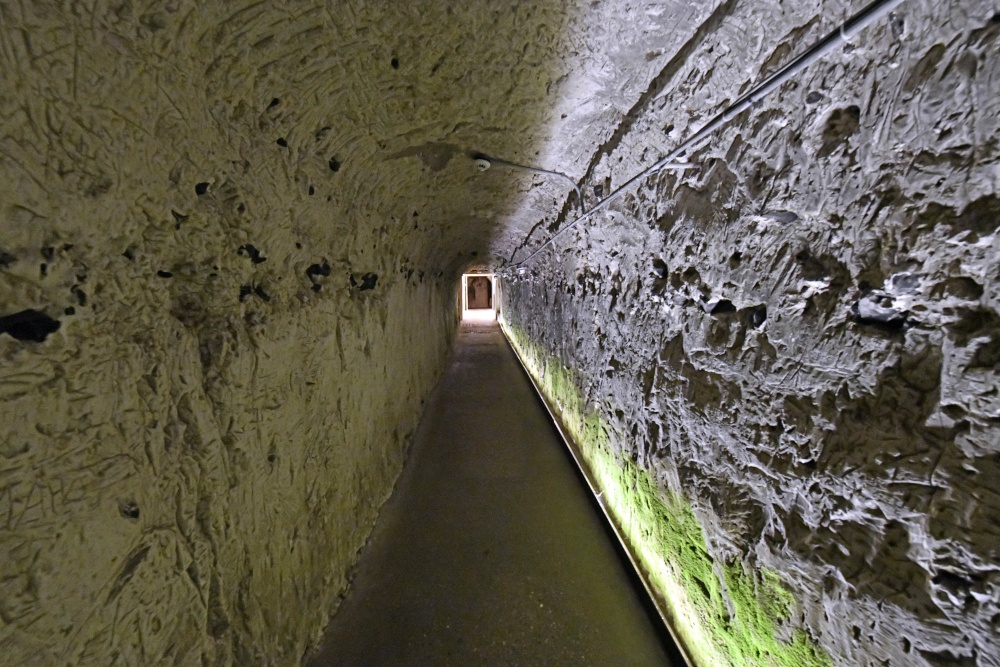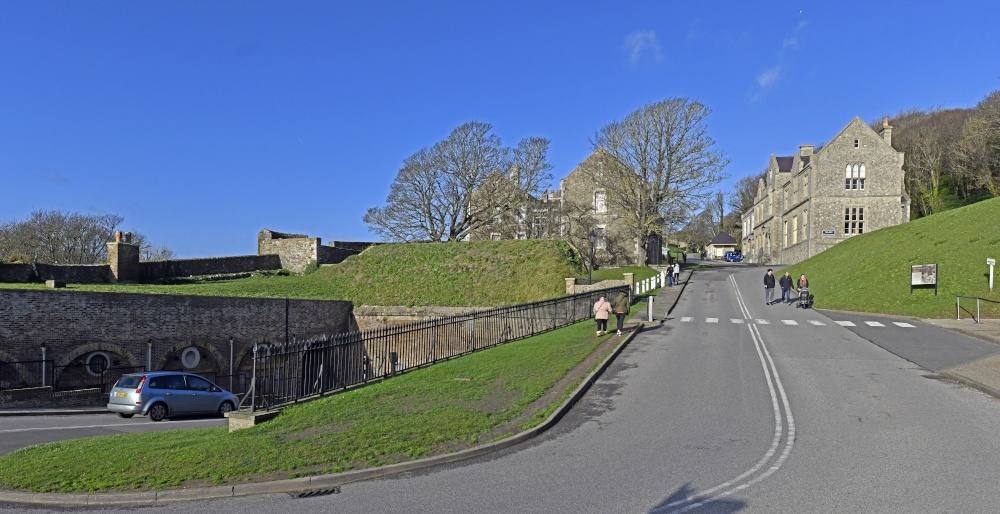Please login or click here to join.
Forgot Password? Click Here to reset pasword
 |
Underground tunnels at Dover Castle When Napoleon loomed large across Europe (and, indeed, he looked out from Boulogne in 1805 with his Grande Armée massed to attack, but in the end he turned away), Britain needed men ready to repulse him. Dover was thought a likely target, so the medieval castle defences were remodelled and brought into the artillery age. But there wasn’t space to house the men to man the guns. The solution was to go underground. Tunnels were dug into the cliffs, seven in all, parallel to one other below the cliff-top. By 1803 this ingenious underground barracks was opened, housing at its peak some 2000 officers and soldiers. Ultimately, Napoleon never invaded, so that might have been an end for the tunnels. However, in 1938, when the threat of war with Nazi Germany hung heavy in the air, the tunnels were brought back into action as the headquarters for the newly constituted Dover Naval Command, charged with protecting the Channel from enemy action. It became a rather more important place much sooner than the British military top brass would have hoped, after Germany’s lightning-quick advance in the Battle of France in May 1940 left the entire British Expeditionary Force surrounded and in imminent danger of annihilation, backed up against the wrong side of the Channel at Dunkirk. Responsibility for getting the stranded army home was dropped on the shoulders of Vice Admiral Bertram Ramsay, head of Dover Naval Command, from his base within those old tunnels. As James Holland says, ‘In 1940 it was a key place because it was where the Dunkirk evacuation – code-named Operation Dynamo – was organised.’ The speed of Hitler’s success meant that Ramsay had precious little time to come up with answers to the terrifying logistical exercise that faced him. Yet over the course of just nine days, starting on 26 May 1940, he and his tunnel-based team orchestrated the evacuation of some 338,000 soldiers in as many Royal Navy vessels as he could muster, along with the now-famous flotilla of civilian ‘little ships’. Churchill called it a ‘miracle of deliverance’, and given that initial estimates suggested that only 45,000 men were likely to be rescued, a miracle it must have seemed. This picture appears in the following picture tour: Camera Make: NIKON CORPORATION� Model: NIKON D850� |
 |
Underground tunnels at Dover Castle When Napoleon loomed large across Europe (and, indeed, he looked out from Boulogne in 1805 with his Grande Armée massed to attack, but in the end he turned away), Britain needed men ready to repulse him. Dover was thought a likely target, so the medieval castle defences were remodelled and brought into the artillery age. But there wasn’t space to house the men to man the guns. The solution was to go underground. Tunnels were dug into the cliffs, seven in all, parallel to one other below the cliff-top. By 1803 this ingenious underground barracks was opened, housing at its peak some 2000 officers and soldiers. Ultimately, Napoleon never invaded, so that might have been an end for the tunnels. However, in 1938, when the threat of war with Nazi Germany hung heavy in the air, the tunnels were brought back into action as the headquarters for the newly constituted Dover Naval Command, charged with protecting the Channel from enemy action. It became a rather more important place much sooner than the British military top brass would have hoped, after Germany’s lightning-quick advance in the Battle of France in May 1940 left the entire British Expeditionary Force surrounded and in imminent danger of annihilation, backed up against the wrong side of the Channel at Dunkirk. Responsibility for getting the stranded army home was dropped on the shoulders of Vice Admiral Bertram Ramsay, head of Dover Naval Command, from his base within those old tunnels. As James Holland says, ‘In 1940 it was a key place because it was where the Dunkirk evacuation – code-named Operation Dynamo – was organised.’ The speed of Hitler’s success meant that Ramsay had precious little time to come up with answers to the terrifying logistical exercise that faced him. Yet over the course of just nine days, starting on 26 May 1940, he and his tunnel-based team orchestrated the evacuation of some 338,000 soldiers in as many Royal Navy vessels as he could muster, along with the now-famous flotilla of civilian ‘little ships’. Churchill called it a ‘miracle of deliverance’, and given that initial estimates suggested that only 45,000 men were likely to be rescued, a miracle it must have seemed. This picture appears in the following picture tour: Camera Make: NIKON CORPORATION� Model: NIKON D850� |
 |
Underground tunnels at Dover Castle When Napoleon loomed large across Europe (and, indeed, he looked out from Boulogne in 1805 with his Grande Armée massed to attack, but in the end he turned away), Britain needed men ready to repulse him. Dover was thought a likely target, so the medieval castle defences were remodelled and brought into the artillery age. But there wasn’t space to house the men to man the guns. The solution was to go underground. Tunnels were dug into the cliffs, seven in all, parallel to one other below the cliff-top. By 1803 this ingenious underground barracks was opened, housing at its peak some 2000 officers and soldiers. Ultimately, Napoleon never invaded, so that might have been an end for the tunnels. However, in 1938, when the threat of war with Nazi Germany hung heavy in the air, the tunnels were brought back into action as the headquarters for the newly constituted Dover Naval Command, charged with protecting the Channel from enemy action. It became a rather more important place much sooner than the British military top brass would have hoped, after Germany’s lightning-quick advance in the Battle of France in May 1940 left the entire British Expeditionary Force surrounded and in imminent danger of annihilation, backed up against the wrong side of the Channel at Dunkirk. Responsibility for getting the stranded army home was dropped on the shoulders of Vice Admiral Bertram Ramsay, head of Dover Naval Command, from his base within those old tunnels. As James Holland says, ‘In 1940 it was a key place because it was where the Dunkirk evacuation – code-named Operation Dynamo – was organised.’ The speed of Hitler’s success meant that Ramsay had precious little time to come up with answers to the terrifying logistical exercise that faced him. Yet over the course of just nine days, starting on 26 May 1940, he and his tunnel-based team orchestrated the evacuation of some 338,000 soldiers in as many Royal Navy vessels as he could muster, along with the now-famous flotilla of civilian ‘little ships’. Churchill called it a ‘miracle of deliverance’, and given that initial estimates suggested that only 45,000 men were likely to be rescued, a miracle it must have seemed. This picture appears in the following picture tour: Camera Make: NIKON CORPORATION� Model: NIKON D850� |
 |
Plan of underground tunnels at Dover Castle Dover Castle is a medieval castle in Dover, Kent, England. It was founded in the 11th century and has been described as the "Key to England" due to its defensive significance throughout history. It is the largest castle in England. This picture appears in the following picture tour: Camera Make: NIKON CORPORATION� Model: NIKON D850� |
 |
View from Dover Castle Dover Castle is a medieval castle in Dover, Kent, England. It was founded in the 11th century and has been described as the "Key to England" due to its defensive significance throughout history. It is the largest castle in England. This picture appears in the following picture tour: Camera Make: NIKON CORPORATION� Model: NIKON D850� |
 |
View from Dover Castle Dover Castle is a medieval castle in Dover, Kent, England. It was founded in the 11th century and has been described as the "Key to England" due to its defensive significance throughout history. It is the largest castle in England. This picture appears in the following picture tour: Camera Make: NIKON CORPORATION� Model: NIKON D850� |
 |
Dover Castle Dover Castle is a medieval castle in Dover, Kent, England. It was founded in the 11th century and has been described as the "Key to England" due to its defensive significance throughout history. It is the largest castle in England. This picture appears in the following picture tour: Camera Make: NIKON CORPORATION� Model: NIKON D850� |
 |
Dover Castle This picture appears in the following picture tours: Camera Make: NIKON CORPORATION� Model: NIKON D300S� 1 person has added this picture to their favourites |